Keeping your camper van warm during cold weather is essential for comfort and safety. Here’s a step-by-step guide to help you heat your camper van effectively:
- Insulate Your Van: Start by insulating your van to retain heat. Use materials like foam board, spray foam, or reflective insulation. Insulate the walls, floor, and ceiling to minimize heat loss.
- Install a Heater: Choose a heating system that suits your needs. Popular options include propane heaters, diesel heaters, and electric heaters. Propane and diesel heaters are efficient and can be installed permanently, while electric heaters are portable but require a reliable power source.
- Ventilation: Ensure proper ventilation to prevent condensation and maintain air quality. Install roof vents or windows that can be opened slightly to allow fresh air in while keeping the heat inside.
- Use Thermal Curtains: Install thermal curtains or insulated window covers to reduce heat loss through windows. These can be easily made or purchased and help keep the warmth inside.
- Portable Heaters: Consider using portable heaters as an additional heat source. Electric space heaters or propane heaters can provide extra warmth but should be used with caution to avoid fire hazards.
- Heat Distribution: Use fans to distribute heat evenly throughout the van. Small, battery-operated fans can help circulate warm air and prevent cold spots.
- Warm Bedding: Invest in high-quality, warm bedding such as thermal sleeping bags, blankets, and insulated mattress toppers. These will help you stay warm during the night without relying solely on your heating system.
- Dress in Layers: Wear multiple layers of clothing to retain body heat. Thermal underwear, wool socks, and insulated jackets can make a significant difference in keeping you warm.
- Hot Water Bottles: Use hot water bottles or heating pads to provide localized warmth. These can be placed in your bed or used to warm up specific areas of the van.
- Regular Maintenance: Maintain your heating system regularly to ensure it operates efficiently and safely. Check for any leaks, clean filters, and follow the manufacturer’s maintenance guidelines.

